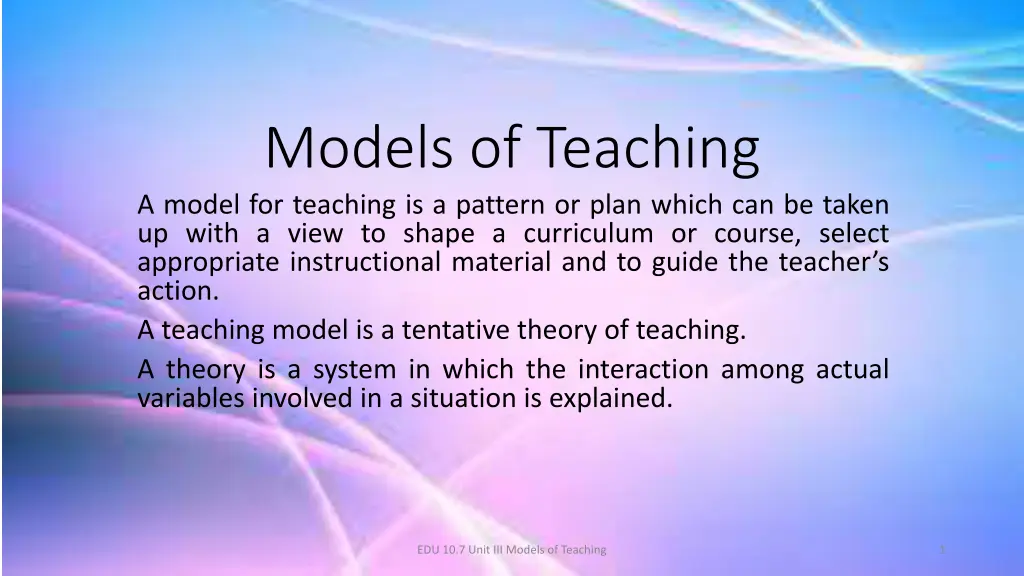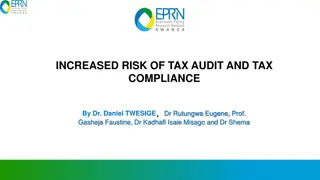
Understanding Models of Teaching in Education
Explore the concept of teaching models, their definitions, assumptions, and roles in shaping educational experiences. Discover how teaching models help create effective learning environments and drive student behavior change.
Download Presentation

Please find below an Image/Link to download the presentation.
The content on the website is provided AS IS for your information and personal use only. It may not be sold, licensed, or shared on other websites without obtaining consent from the author. If you encounter any issues during the download, it is possible that the publisher has removed the file from their server.
You are allowed to download the files provided on this website for personal or commercial use, subject to the condition that they are used lawfully. All files are the property of their respective owners.
The content on the website is provided AS IS for your information and personal use only. It may not be sold, licensed, or shared on other websites without obtaining consent from the author.
E N D
Presentation Transcript
Models of Teaching A model for teaching is a pattern or plan which can be taken up with a view to shape a curriculum or course, select appropriate instructional material and to guide the teacher s action. A teaching model is a tentative theory of teaching. A theory is a system in which the interaction among actual variables involved in a situation is explained. EDU 10.7 Unit III Models of Teaching 1
Definition Definition Teaching models are just instructional designs. They describe the process of specifying and producing particular environmental situations which the student to interact in such a way that specific change occurs in his behavior. ( Bruce Joyce and Marsha Weil- Models of teaching) A teaching model provides a specific outline of teaching activities. 1) Learning outcomes are written in behavioural terms. 2) The appropriate stimulus situations are selected for emitting desired responses of the learner. EDU 10.7 Unit III Models of Teaching 2
3) the learning situations are specified for observing the student responses. 4) The criterion behavior is defined for student performance. 5) The teaching tactics are specified for creating the interaction between students and environment,. 6) The learning situations and teaching tactics are improved and modified for bringing about the desirable change in student s behavior. EDU 10.7 Unit III Models of Teaching 3
Assumptions regarding teaching models Assumptions regarding teaching models 1) Teaching is a means for generating an environment of learning. It involves a number of independent variables influencing student learning. 2) 2) different types of teaching objectives are achieved by organizing teaching elements in different ways. 3) Teaching models provide learning experience by creating appropriate environment conducive to real behavioural outcomes. EDU 10.7 Unit III Models of Teaching 4
Role of Teaching Models Role of Teaching Models It may help a teacher to develop his capacity to teach larger number of children and create conducive environment for their learning. It may help curriculum makers to plan learning centered curriculum which provides a variety of educational experiences to children. It may help to create more interesting and effective instructional materials and learning resources. It may stimulate the developments of new and better forms and opportunities for education. It may help to formulate a comprehensive theory of teaching. EDU 10.7 Unit III Models of Teaching 5
Families of teaching models Families of teaching models There are four families of teaching models. Family I- The information processing Family(focus on intellectual capacity) 1. Concept Attainment Model- Jerome S Bruner 2. Inductive Thinking Model- Hilda Taba 3. Inquiry Training Model- J Richard Suchman 4. Cognitive Development Model- Jean Piaget EDU 10.7 Unit III Models of Teaching 6
Models of this family focus on intellectual capacity. The primary purposes are the following: i. mastering of the methods of inquiry ii. Developing the skill for processing information iii. Fostering the ability to think EDU 10.7 Unit III Models of Teaching 7
Family II- The Personal Family (Focus on the personal development of the individual) 1) Non directive teaching Model-Carl Rogers. The primary goals are: i) To increase the students sense of self worth. ii) to help students understand themselves more fully. iii) To help students refine their emotions. iv) To foster the student s creativity. EDU 10.7 Unit III Models of Teaching 8
Family III: The social family- 1) Group Investigation Model- Herbert Thelen 2) Social Inquiry Model- Thelen, Oliver, Sharer. The models in this family emphasize the relationship of the individual to society. The primary goals are the following: i) To train students work together ii) To develop skills for maintaining human relations. iii) To inculcate personal and social values. EDU 10.7 Unit III Models of Teaching 9
Family IV- The Behavioural Systems Family: Self control through Operant methods- B F Skinner. The common thrust of these models is the emphasis on changing the observable behavior of the learner. The special goals are the following: To develop the competency to adopt behavior styles appropriate to given situations. To learn strategies fro self control through operant methods. . EDU 10.7 Unit III Models of Teaching 10
To master techniques for stress reduction. To foster leadership qualities. Components of a teaching model Four major components are included in all models of teaching and these components vary with the model. The components are 1. Syntax 2. Social system 3. Principles of reaction 4. Support system. EDU 10.7 Unit III Models of Teaching 11
Syntax (Phases or steps): 1. Syntax can be described in terms of sequences of activities called phases. 2. this tells how the various phases in the development of a lesson are sequenced. 3. This indicates how a lesson based upon a particular model begins and through what phases it progresses and culminates in the realization of the development of the goal. 4. This component is of utmost importance. EDU 10.7 Unit III Models of Teaching 12
Social System: i) Every learning situation involves interaction of members associated with it. ii) When the activities of the pupils will be more controlled by external restrictions with a predetermined structuring then that system may be said to be highly structured. iii) If the teacher withdraws to the maximum possible and there is free interaction among the learners then that system may be low structured. EDU 10.7 Unit III Models of Teaching 13
iv. if the teacher and the pupils jointly decide upon the course of action then it is moderately structured. 3. Principles of reaction (Rules to be followed): this is an extension of the social system. This defines the nature of reaction expected from the teacher to every pupil activity. It gives guidance to the teacher as to how he is expected to react to each activity of the learners. EDU 10.7 Unit III Models of Teaching 14
4. Support system: Every teaching model warrants certain conditions and facilities for the realization of the goal. Many environmental facilities other than the books, blackboards etc. will have to be pooled and used. Sometimes the cooperation of various agencies from the society may become necessary. Suitable hardware and software also may be required. In short each model requires a system that supports its nature. EDU 10.7 Unit III Models of Teaching 15
Instructional and Instructional and N Nurturant urturant effects effects This is another aspect that the teacher has to think while planning the lesson. The former is the direct or instructional effects of a lesson as purposefully envisaged by the teacher. The later refers to the indirect or Nurturant effects that might happens as a byproduct. Some of these bye-products may be desirable while others may be undesirable. Eg:- a personal model that gives freedom to the child to behave as he would like to, may result in certain antisocial responses. EDU 10.7 Unit III Models of Teaching 16
The nurturant effect may not be desirable and hence the teacher has to think of precautionary measures. An indirect effect may be desirable and hence worthy of encouragement. A teacher while describing a model has to consider the possible Nurturant effects and classify them as desirable and undesirable. EDU 10.7 Unit III Models of Teaching 17
Concept Attainment Model Concept Attainment Model Developed by Jerome S Bruner and his associates Jacqueline Goodnow and George Austin. Deals with the nature of the concepts and strategies of concept formation. Concepts form the basic vocabulary for efficient learning. It is difficult to register the differences in things and to respond to each items as a unique entity and hence to avoid this, we categorise. While doing so we see things not as unique items but as members of classes we form categories that lead to the formation of concepts. EDU 10.7 Unit III Models of Teaching 18
Concept attainment and concept formation Concept attainment and concept formation Strategies of forming concepts- concept attainment and concept formation. EDU 10.7 Unit III Models of Teaching 19
Concepts Concepts According to Bruner, a concept includes five elements. They are 1) Name of the concept 2) Exemplars (positive and negative) 3) Attributes (essential and non essential) 4) Attribute values 5) Rule /definition of the concept. EDU 10.7 Unit III Models of Teaching 20
Name is the word that describes a concept for communication. Eg. Triangle, leaf, planet democracy etc. Exemplars: these are items that could be used in the process of categorization. i) These may include items that are positive exemplars (exemplars) that obey all the essential cues used for categorization leading to the concepts. ii) This may also consists of negative exemplars (non exemplars) that do not satisfy all the cues of a positive example. iii) Negative exemplars are needed for making the grouping meaningful and definite. EDU 10.7 Unit III Models of Teaching 21
Both positive examples and negative examples are essential because the ability to distinguish positive exemplars definitely is developed only by comparison with related negative exemplars Eg: to make the concept of planet clear, stars may be presented as negative exemplars. Attributes: Attributes are features or characteristics on the basis of which a number of items could be categorized into a particular group or class that represents the concept. Attributes are of two types- Essential attributes and non essential attributes. EDU 10.7 Unit III Models of Teaching 22
For the concept of a triangle, closedness of the figure and three sides that make it are essential attributes. Specific lengths for the sides and specific sizes for the angles are non essential attributes. Attribute value: Each attribute has its value range. Certain attributes are outside these values, and certain attributes has no range at all. Eg:- an angle of 200 (anglesize) is outside the range of the attribute but closedness has no range at all. EDU 10.7 Unit III Models of Teaching 23
Rule is the definition formed to describe a concept on the basis of the essential attributes. Eg: the concept parallelogram is defined as a four-sided figure, with opposite pairs of sides parallel. The definition is formed on the basis of the three essential attributes namely, closedness, four sidedness and parallelism of opposite sides. EDU 10.7 Unit III Models of Teaching 24
A test of concept attainment A test of concept attainment A individual may be said to have attained a concept if he possesses: 1) Ability to categorise exemplars and non-exemplars. 2) Ability to describe the exemplars in terms of essential attributes. 3) Ability to generate one s own exemplars. EDU 10.7 Unit III Models of Teaching 25
Strategies for concept attainment Strategies for concept attainment According to Bruner there are four strategies. They are 1. Simultaneous scanning ( using concept hypotheses many at a time) 2. Successive scanning (using concept hypotheses one at a time) 3. Conservative focusing (using attributes many at a time) 4. Focus gambling (using attributes one at a time) EDU 10.7 Unit III Models of Teaching 26
Description of the model-CAM SYNTAX Phase I Presentation of data and identification of the concept Teacher- presents labelled (as Yes or No) exemplars a) Students -compare attributes in positive and negative exemplars. b) generate and test hypotheses c) Attempts a definition according to the essential attributes. EDU 10.7 Unit III Models of Teaching 27
Phase 2 Testing Attainment of the Concept Students classify unlabeled examples as Yes or No. Teacher confirms hypothesis, gives the name and helps arrive at the restatement of the definition. Students generate more examples. EDU 10.7 Unit III Models of Teaching 28
Phase 3 Analysis of the thinking strategies Students describe a) Thoughts b) The role of hypotheses and attributes c) Type and number of hypotheses EDU 10.7 Unit III Models of Teaching 29
Social system: teacher carefully prepares in advance exemplars and non exemplars and labels them and sequences them. Teacher acts as a recorder. Teacher provides additional examples. The system is highly structured. EDU 10.7 Unit III Models of Teaching 30
Principles of reaction: Supports the pupils hypotheses and creates dialogue. Again becomes supportive at the final phase. Encourages different strategies. Support system: Material namely in the form of positive and negative exemplars. EDU 10.7 Unit III Models of Teaching 31
Instructional and Nurturant Effects: 1. Instructional effects: Gets clear notions about nature of concepts. Develops skills in using appropriate concept-building strategies. Attains the specific concepts. Develops skills in inductive reasoning. EDU 10.7 Unit III Models of Teaching 32
2. Nurturant Effects: Sensitivity to logical reasoning. Tolerance of ambiguity and initial errors. A sense of using alternative perspectives. EDU 10.7 Unit III Models of Teaching 33
INQUIRY TRAINING MODEL INQUIRY TRAINING MODEL Whenever we are engaged in the process of findingout or investigating through questions, we are involved in the process of inquiry. If the inquiry takes the form of disciplined and systematic approach, it becomes the spirit of scientific method. training the learners for investigating and explaining any type of puzzling problem, phenomenon or event, can be a way of orienting their minds towards scientific inquiry. EDU 10.7 Unit III Models of Teaching 34
Inquiry training model was developed by Richard Suchman to teach students a process for investigating and explaining unusual phenomena. It aims at the development of independent learners through active participation in scientific inquiry. The general goal of inquiry training is to help students develop intellectual discipline and skills necessary to raise questions and search out answers stemming from their curiosity. Suchman is interested in helping students inquire independently, but in a disciplined way. EDU 10.7 Unit III Models of Teaching 35
Assumptions behind ITM 1. Students inquire naturally when they are puzzled. 2. they can become conscious of and learn to analyze their thinking strategies. 3. New strategies can be taught directly and added to students existing ones. EDU 10.7 Unit III Models of Teaching 36
Specific objectives of ITM Specific objectives of ITM 1. to develop scientific process skills- observing, collecting and organizing data, identifying and controlling variables, formulating and testing hypothesis and the ability to explain and infer. 2. to develop among students the strategies for creative inquiry. 3. to develop among students an independence or autonomy in learning. 4. to develop among students the ability to tolerate ambiguity. 5. to make the students understand the tentative nature of knowledge. EDU 10.7 Unit III Models of Teaching 37
Phases of ITM Phases of ITM Phase I- Encounter with the problem The teacher presents the preplanned discrepant event and explains the inquiry procedures. EDU 10.7 Unit III Models of Teaching 38
Phase II- Data gathering Verification The about the nature and identity of the objects, events, properties and conditions related to the problem. students inquire EDU 10.7 Unit III Models of Teaching 39
Phase- III- Data gathering- Experimentation Asks the students to organize the data which they have gathered and to give appropriate which fits the data. the explanation most EDU 10.7 Unit III Models of Teaching 40
Phase IV- Formulating rules or explanations Teacher asks the students to formulate rules based on the third phase EDU 10.7 Unit III Models of Teaching 41
Phase V- Analysis of the inquiry procedure Asks the students to analyse the pattern of inquiry. EDU 10.7 Unit III Models of Teaching 42






















